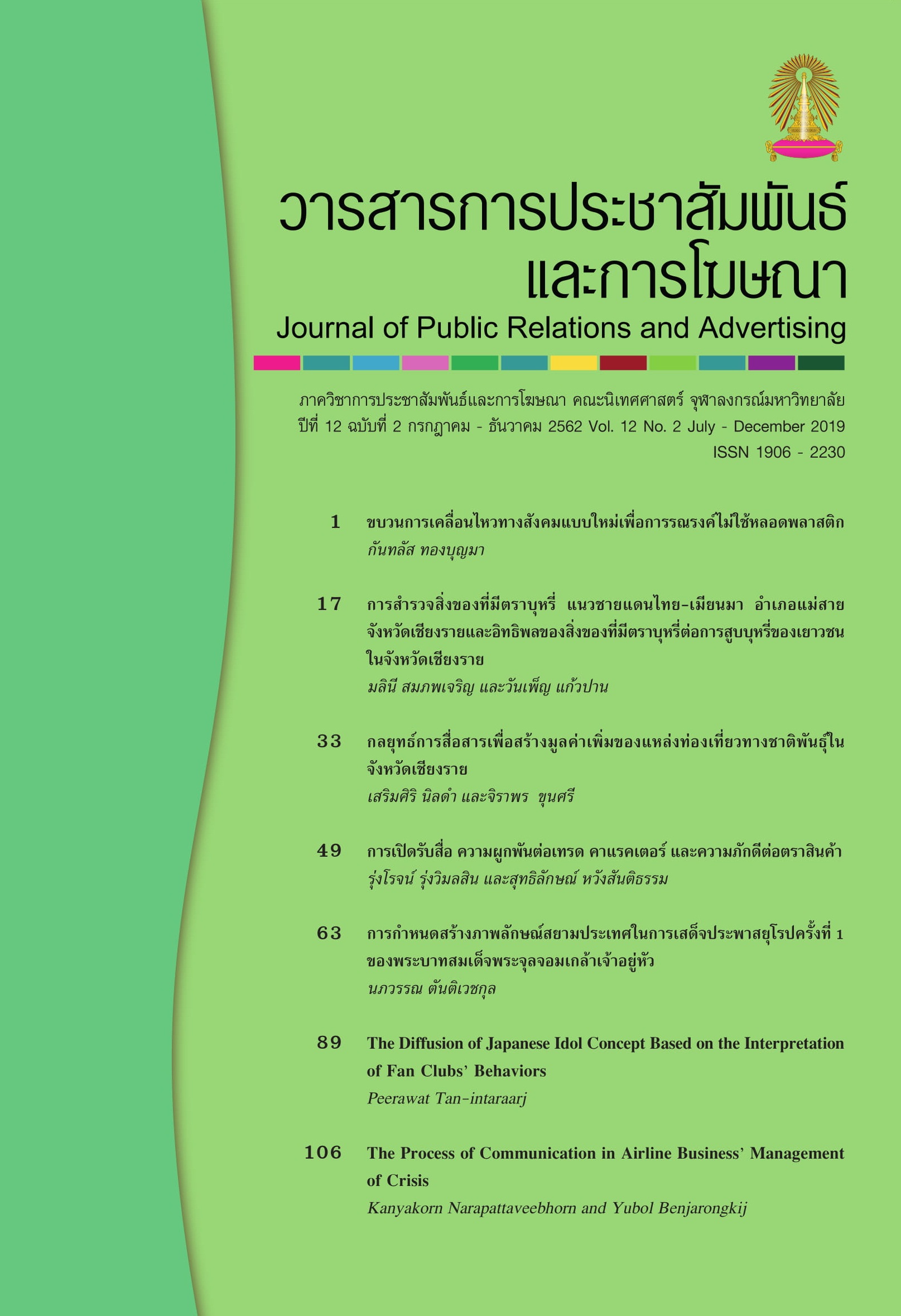The Diffusion of Japanese Idol Concept Based on the Interpretation of Fan Clubs’ Behaviors
Main Article Content
Abstract
The concept of Japanese female idol groups is now being applied more widely outside Japan. BNK48 is an idol group in Thailand that has applied this concept as a branch of the Japanese AKB48. At its start, it had a small number of fans; however, however they have risen since the release of their second single, “Koisuru Fortune Cookie”. Basically, the concept of Japanese female idol groups reflects a culture different from the Thai context. For this reason, this study was initiated to better understand how a Thai individual becomes a fan of BNK48 through observation.
The research was conducted based on the phenomenological concept and observation generated through an individual’s experience. The four elements of Diffusion of Innovations Theory (innovation, time, communication channels and a social system) and Bandura’s Social Learning Theory were applied to clarify the findings collected through in-depth interviews and the observational research. For the in-depth interviews, all key informants who participated in this study admitted that they are BNK48 fans. The in-depth interview results show that social media and peers have an influence on key informants’ adoption. However, in the long term, the Thai context also has an effect on key informants. Although BNK48 applies the Japanese concept, key informants adopt this concept because they understand it easily, which is actually conveyed through a Thai context. Through observation, it was found that apparent behaviors are both aggressive, but positive, and non-aggressive. These behaviors are clarified in this study. Further research can apply this study’s findings to examine other cross-cultural relationships and how they are adopted.
Article Details
References
Bandura, A., Ross, D., & Ross, S. A. (1961). Transmission of Aggression through Imitation of Aggressive Models. Journal of Abnormal and Social Psychology, 63(3), 575-582.
Bandura, A. (1977). Social learning theory. Englewood Cliffs, NJ: Prentice-Hall.
Basil, M. D. (1996). Identification as a Mediator of Celebrity Effects. Journal of Broadcasting & Electronic Media, 40(4), 478-495.
Bottos, S. (2007). Women and violence: Theory, risk, and treatment implications. Ontario, Canada. Retrieved October 15, 2018. from http://www.csc-scc.gc.ca/research/092/r198-eng.pdf
Chen, L. (2018). Chinese Fans of Japanese and Korean Pop Culture: Nationalistic Narratives and International Fandom. New York: Routledge.
Fan, J. (2014). Exchanging Influence between American and Chinese Culture and Music (Master’s Thesis). Dartmouth College. New Hampshire.
Foley, J. & Thomson, L. (2017). Language Learning: A Life Long Process. New York: Routledge.
Fox, K. A.; Nobles, M. R. and Akers, R. L. (2011). Is stalking a learned phenomenon? An empirical test of social learning theory. Journal of Criminal Justice, 39(1), 39-47.
Galbraith, P. & Karlin, J. (2012). Idols and Celebrity in Japanese Media Culture: Basingstoke. Palgrave Macmillan.
Gracia, R. & Dimyati, D. (2016). Engaging with Anime and Manga: A Phenomenology Study. Procedia: Social and Behavioral Sciences. Retrieved October 10, 2018 from https://repository.telkomuniversity.
ac.id/pustaka/files/123506/article_f/engaging-with-anime-and-manga-a-phenomenological-study-proceeding-international-conference-on-transformation-in-communication-icotic-november-2016.pdf
Hassan, N., Sallehuddin, I., & Aziz, N. (2016). Study on Anime and Its Impacts among University Student. Paper presented at the Pasak 2016: International Conference on Social Sciences and Humanities, International Islamic University College Selangor, Selangor.
Hiroshi, A. (2000). Pop Idol and the Asian Identity. In T. J. Craig (Ed.), Japan Pop!: Inside the World of Japanese Popular Culture (pp. 309-326). New York: An East Gate Book.
Leuthold, S. (2011). Cross-cultural Issues in Art: Frames for Understanding. New York: Routledge.
MacWilliams, M. (2008). Japanese Visual Culture: Explorations in the world of Manga and Anime. New York: Routledge.
Rogers, E. (1962). Diffusion of Innovations. New York: Free Press of Glencoe.
Ryckman, R. M. (2013). Theories of personality. California: Wadsworth Publishing.
Scheibe, C. (2007). Piaget and power rangers. Retrieved October 29, 2018, from http://www.projectlooksharp.
org/Articles/Piaget_and_the_Power_Rangers.pdf
Slotsve, T., Del Carmen, A., Sarver, M., and Villareal-Watkins, R. J. (2008). Television violence and aggression: a retrospective study. Southwest Journal of Criminal Justice, 5(1), 22-49.
Stever, G. (2010). Fan Behavior and Lifespan Development Theory: Explaining Para-social and Social Attachment to Celebrity. Journal of Adult Development, 18(1), 1-7.
Sone, Y. (2017). Japanese Robot Culture: Performance, Imagination, and Modernity. New York: Palgrave Macmillan.
Soraya, R. & Muktiono, D. (2013). JKT48 as the New Wave of Japanization in Indonesia. Allusion, 2(2), 17-35.
Thomas, G., Morgan, K., & Harris, K. (2016). Observational Learning in Coaching. In L. Nelson, R. Groom, & P. Potrac (Eds.), Learning in Sports Coaching: Theory and Application (pp. 22-34). New York: Routledge.
Tong, X. (2005). Parents from America and Children from China: A Phenomenological Study of Cross-Cultural Adoption (Doctoral Dissertation). University of Denver, Denver.
Ueda, Y. (2016). Image Strategy of Nogizaka46: How Do Young People Perceive It?. Bulletin of Seikei University, 49(5), 1-20.
Vickers, K. (2007). Aging and the media: Yesterday, today, and tomorrow. Californian Journal of Health Promotion, 5(3), 100-105.


